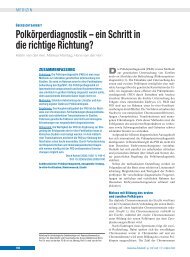(Microsoft PowerPoint - Prävention von Frühaborten.ppt)
(Microsoft PowerPoint - Prävention von Frühaborten.ppt)
(Microsoft PowerPoint - Prävention von Frühaborten.ppt)
Erfolgreiche ePaper selbst erstellen
Machen Sie aus Ihren PDF Publikationen ein blätterbares Flipbook mit unserer einzigartigen Google optimierten e-Paper Software.
Strategien bei <strong>Frühaborten</strong><br />
Christian Gnoth<br />
GMP Tigges/Friol/Gnoth, Praxisklinik für Reproduktionsmedizin, Grevenbroich
Spontanabortsraten:<br />
• Nach positivem Ss-Test: ~ 25-30 %<br />
• Klinische Ss 6.-10. SSW: ~ 15 %<br />
• Klinische Ss 10.-12. SSW: ~0,8 – 1,9 %
Abortrate klinischer Schwangerschaften nach dem<br />
Nachweis fetaler Herzaktionen<br />
%<br />
Abortrate intakter Schwangerschaften<br />
abhängig vom Alter<br />
9<br />
8<br />
7<br />
6<br />
5<br />
4<br />
3<br />
2<br />
1<br />
0<br />
(nach Hoesli et al., Am J Med Genetics, n= 2543)<br />
(n= 2543, nach Hoesli et al., Am J Med Genetics, 2001<br />
0,75<br />
0,77<br />
Odds ratio<br />
0,77<br />
1,01<br />
2,12<br />
16-19 20-24 25-29 30-34 35-39 Alle
Abortrate im Deutschen IVF Register (DIR)<br />
2001<br />
Spontanrate: ~ 15 %
Präkonzeptionell:<br />
• Z.n. Frühabort/Spätabort<br />
• anamnestisch habitueller Abortneigung<br />
• Sterilitätspatientin<br />
• Patientinnen mit Begleiterkrankungen (z.B. D. mellitus, Gerinnungsst.)<br />
Postkonzeptionell:<br />
• Blutungen in der Frühschwangerschaft<br />
• Ss. n. Sterilitätstherapie<br />
Problem der Frühaborte in der<br />
frauenärztlichen Sprechstunde<br />
• Ss. mit Z.n. ≥ 3 Fehlgeburten in der Anamnese<br />
• Schwangere mit Begleiterkrankungen (z.B. D. mellitus, Gerinnungsst.)
Abortursachen:<br />
� Anatomisch: Uterusfehlbildungen, Myome<br />
� Genetisch: numerische Chromosomenaberrationen (50%<br />
aller Spontanaborte, habituelle Aborte: strukturelle<br />
Aberrationen und balancierte Translokationen)<br />
� Endokrinologisch: Lutealphasendefekte (40%, Daya et al.<br />
1988)<br />
� Hämatologisch: Thrombophilie, Sichelzellanämie, Thalassämie<br />
� Infektionen: bei <strong>Frühaborten</strong> vor allem Chlamydien<br />
� Andrologisch: Teratozoospermie<br />
� Immunologisch: HLA-sharing ???, Neu: HLA-G Mutationen!<br />
Autoimmune Systemerkrankungen: SLE, symptomatisches<br />
Antiphospholipidsyndrom<br />
� Psyche: Problem Ursache-Wirkung: „tender loving care“<br />
� Umwelt: Arbeiterinnen in der Metallindustrie, chem.<br />
Laboratorien, Stewardessen, Elektroindustriearbeiterinnen
%<br />
Chromosomenanomalien bei Feten <strong>von</strong> Frauen über 35<br />
Jahren bei der pränatalen Diagnostik<br />
(nach Ferguson-Smith und Yates, 1984)<br />
8<br />
7<br />
6<br />
5<br />
4<br />
3<br />
2<br />
1<br />
0<br />
35<br />
36<br />
37<br />
38<br />
39<br />
40<br />
41<br />
42<br />
43<br />
44<br />
45<br />
Alle >=35
Risiko Patientin:<br />
• PCO-Syndrom (Insulinresistenz, Adipositas p.m.)<br />
• Corpus luteum-Insuffizienz<br />
• Uterus myomatosus (Evidenz: intramurale Myome<br />
> 3-4 cm)<br />
• Uterus (sub-) septus<br />
• Chlamydieninfektionen<br />
• Anti-Phospholipidsyndrom<br />
• APC-Resistenz (Faktor V-Leiden Mutation)<br />
• Prävalenz <strong>von</strong> strukturellen<br />
Chromosomenanomalien (infertile Männer und<br />
Frauen) x 5<br />
• Alter
Risiko Therapie:<br />
• Stimulation (LH, Downregulation,<br />
Stimulationsdauer) bestimmt mit die Eizellqualität<br />
• Temperaturkonstanz (Op, Labor)<br />
• Kulturmedium (Zusammensetzung)<br />
• ICSI-Technik (Eizelltrauma)<br />
• PN-Scoring<br />
• Embryotransfertechnik (Endometriumsverletzung)<br />
• Lutealphasenunterstützung (Implantation)<br />
• Substitution in der Frühschwangerschaft (Abort,<br />
Gestose, IUR, Abruptio placentae)
Präkonzeptionelle Diagnostik bei<br />
habituellen Aborten<br />
� Humangenetische Beratung des Ehepaares, ggf.<br />
Durchführung einer Chromosomenanalyse.<br />
� Karyotypisierung des Abortmaterials falls<br />
möglich. Vaginale UltraschallUntersuchung.<br />
� Hysteroskopie.<br />
� Abklärung angeborener und erworbener<br />
thrombophiler Faktoren.<br />
Nicht:<br />
� Bestimmung antipaternaler<br />
lymphozhytotoxischer Antikörper.<br />
� Bestimmung <strong>von</strong> NK-Zellen im peripheren Blut.<br />
� Bestimmung des TH2/TH1-Ratio.<br />
� Bestimmung <strong>von</strong> LH in der Follikelphase.<br />
� Mikrobiologischer Abstrich der Zervix.
Beispiele für präkonzeptionelle<br />
therapeutische Ansatzpunkte:<br />
� PCO-Syndrom<br />
� Corpus luteum-Insuffizienz<br />
� APC/APS-Screening und Therapie<br />
� Oozytenselektion / PN-Scoring/<br />
Polkörperbiopsie/Poloscopie<br />
� Diabeteseinstellung<br />
� Sanierung der vaginalen Flora
PCOS and Miscarriage Rate<br />
• PCOS is the most frequent reason for<br />
sterility in North America.<br />
• In addition to the unfavourable<br />
conception rate there is a high<br />
miscarriage rate (30-50%) during<br />
the first trimester.<br />
Jakubomicz et al JCEM 87, 524, 2002
PCOS & recurrent pregnancy<br />
36-56% of women<br />
with recurrent<br />
pregnancy loss<br />
have PCOS by<br />
ultrasound.<br />
loss<br />
ACOG Practice Bulletin 24, 426, 2001
Hypothese Abort bei PCOS<br />
Hyper-LH-ämie<br />
Hemmung des „meiosis inhibiting peptid“<br />
Erhöhung der Rate chromosomal aberranter Eizellen<br />
Implantationsversagen und Abort<br />
Senkung des LH-Spiegels durch<br />
Downregulation mit GnRHa über 1-3<br />
Monate
Corpus luteum - Insuffizienz<br />
Progesteron ist bei den meisten Tieren<br />
und beim Menschen essentiell<br />
für die Erhaltung der Schwangerschaft.<br />
Sekeres-Bartho Immunsuppression by progesterone in pregnancy<br />
CRC-Press, Boca Raton 1992
Progesterone is the dominant hormone<br />
during mammalian pregnancy. It<br />
protects the allogenic conceptus from<br />
immunologic rejection.<br />
Stephenson Adv. Contr. Deliv. Syst. Vi, 332, 1990
Estradiol is also crucial for normal<br />
pregnancy development.<br />
Albrecht et al Am. J. Obstet. Gynecol. 182, 432, 2000
Die Quellen für Progesteron und Östradiol in<br />
der frühen Schwangerschaft:<br />
Corpus luteum<br />
Plazenta
Die Produktion und<br />
Sekretion<br />
<strong>von</strong> Progesteron<br />
und Östradiol<br />
wird durch<br />
plazentares HCG<br />
bestimmt
The value of the HCG-doubling<br />
time in pregnancy failure<br />
Doubling time<br />
48 hrs.<br />
72 hrs.<br />
96 hrs.<br />
HCG mIU/ml<br />
up to 2000<br />
2000-6000<br />
>6000<br />
Batzer et al Fert. Steril. 35, 307, 1981
Fehlende Verdoppelungszeit zeigt an:<br />
1. Ektopische Schwangerschaft<br />
2. Trophoblastabnormalitäten<br />
3. Gestörte Plazentation<br />
4. Genetische Abnormalitäten
A single serum HCG level 16 days after ovulation provides a useful<br />
predictor of pregnancy outcome, (Homan FS 2000).
The mean plasma concentrations of HCG, progesterone,<br />
17αOH-progesterone, unjugated estrone, estradiol and estriol<br />
during the first trimester of pregnancy.<br />
(Ryan, 1980)
Yen: Maternal Fetal Medicine. Saunders, Philadelphia<br />
1994
Die Bedeutung <strong>von</strong> Progesteron für die<br />
Implantation und<br />
Schwangerschaftsentwicklung I<br />
1. Vorbereitung des Endometriums für die<br />
Implantation (sekretorische Veränderung)<br />
2. Dezidualisierung des Endometriums<br />
3. Produktion einer Reihe <strong>von</strong> endometrialen<br />
Proteinen (z.B. Uteroglobin, PAPP, PP14 usw.)<br />
4. Regulierung der zellulären Immunität<br />
5. Stimulation der Prostaglandin E2 Produktion<br />
und damit Unterdrückung einer Reihe <strong>von</strong> Tzell-Reaktionen
Die Bedeutung <strong>von</strong> Progesteron für die<br />
Implantation und<br />
Schwangerschaftsentwicklung II<br />
6. Stimulation der Lymphozytenproliferation an<br />
der feto-maternalen Grenzschicht<br />
7. Unterdrückung der durch Interleukin-2<br />
erhöhten zellulären Zytotoxizität<br />
8. Unterdrückung der T-Zell und Killer-Zellaktivitäten<br />
9. Wechsel <strong>von</strong> Th1- zu den Th2- zellen<br />
10. Synthese des „progestin-induced-blockingfactor“<br />
(PIBF)<br />
11. Unterdrückung <strong>von</strong> Matrixmetalloproteinasen
Möglichkeiten der Fehlgeburten aufgrund <strong>von</strong><br />
Abnormalitäten des Progesterons und des<br />
Östradiols<br />
1. Corpus luteum Insuffizienz. Entweder Progesteron oder<br />
Progesteron/Östradiol primär niedrig (4/5 SSW) oder<br />
sekundär abfallend bis zur 11.SSW<br />
2. Rückbildung der überstimulierten Ovarien nach<br />
Follikelstimulation und Ovulationsauslösung mit einem<br />
Abfall <strong>von</strong> Progesteron und Östradiol bis zur 11. SSW<br />
3. Gestörte bzw. ungenügende Plazentation oder<br />
Trophoblastfehlfunktion mit verzögerter<br />
Progesteronsekretion zwischen der 11. und 20. SSW
Endokrine Hauptursachen für<br />
spontane und habituelle Aborte<br />
1. Corpus luteum Insuffizienz<br />
2. Defekter „Luteo-plazentarer Shift“<br />
3. Verzögerung der plazentaren<br />
Progesteronsynthese und -sekretion<br />
Christensen, Schindler; Zbl. Gynäk. 119, 462,<br />
1997<br />
Yen; Endocrinology of pregnancy, 1994<br />
Römmler, Kreutzer; Gyne 19, 168, 1998
Prediction of abnormal gestation by<br />
progesterone in spontaneous and<br />
chlomiphene-induced cycles<br />
Type of cycle<br />
Spontaneous<br />
Chlomiphenestimulated<br />
Discriminatory<br />
P-conzentration<br />
10 ng/ml (32 nmol/l)<br />
30 ng/ml (95 nmol/l)<br />
Long et al Fert. Steril 61.838, 1994
Progesterone in repeated miscarriages:<br />
Treatment protocol I<br />
� 48 patients were given Duphaston ® 10mg<br />
orally, twice daily<br />
� 36 patients were given hCG 5000 IU every<br />
4 days, IM (Profasi ® or Pregnyl ® )<br />
� 30 patients received no therapy<br />
� Treatment started after diagnosis of<br />
pregnancy (pregnancy test) and stopped<br />
at the 12 th gestational week<br />
El-Zibdeh MY. Gynecological Endocrinology 2001; 15 (S5): 44.
Treatment Protocol<br />
Progesterone in threatening<br />
miscarriage: Treatment protocol II<br />
� 86 patients were given Duphaston ®<br />
10mg orally, twice daily<br />
� 60 patients were given standard therapy<br />
� Treatment started when the patient<br />
presented with bleeding and was<br />
continued for one week after the<br />
bleeding had stopped<br />
El-Zibdeh MY. Gynecological Endocrinology 2001; 15 (S5): 44.
•Viable<br />
pregnancy<br />
(delivery)<br />
•Abortion<br />
Pregnancy Outcome<br />
85.4 %<br />
(41/48)<br />
14.6 %<br />
(7/48)<br />
I--------------------------- p
Conclusion:<br />
– In Habitual Abortion<br />
10mg orally, twice daily until the 20 th<br />
week of pregnancy<br />
– In Threatened Abortion<br />
40mg at once, then 10mg every 8h until<br />
symptoms remit
Theorie: Corpus luteum – Insuffizienz →<br />
inkompetente Implantantion<br />
Abort Gestose IUR preterm labor stillbirth<br />
Decrescendo des Implantationsfehlers<br />
Adäquate Stimulation der Follikelreifung<br />
Voraussetzung für eine kompetentes Corpus<br />
luteum<br />
Ausreichende Supplementierung mit<br />
Progesteron und Estradiol bis in die 8.-12.<br />
SSW (Farhi et al., Fertil Steril, 2000) mindestens
Review: The changing role of progesterone in<br />
preterm labour.<br />
Di Renzo GC, Rosati A, Mattei A, Gojnic M, Gerli S.<br />
BJOG. 2005 Mar;112 Suppl 1:57-60<br />
“Progesterone is efficacious when continuation of<br />
pregnancy is hampered by immunological factors, luteinic<br />
and neuroendocrine deficiencies and myometrial<br />
hypercontractility. This may explain the reduction in the<br />
incidence of preterm birth in high risk pregnant women<br />
using high-dosage prophylactic progesterone“<br />
(250mg 17α-hydroxyprogesterone caproat/week 16-20 weeks of<br />
gestation)
Progestogen for preventing miscarriage.<br />
Oates-Whitehead RM, Haas DM, Carrier JA.<br />
Cochrane Database Syst Rev. 2003;(4)<br />
“In a subgroup analysis of three trials involving<br />
women who had recurrent miscarriages (three or<br />
more consecutive miscarriages), progestogen<br />
treatment showed a statistically significant<br />
decrease in miscarriage rate compared to placebo<br />
or no treatment.”
Gravibinon®<br />
250mg 17α-Hydroxyprogesteroncaproat<br />
Alternativ:<br />
8mg Estradiolvalerat<br />
i.m.<br />
Proluton Depot® ( 250 mg):<br />
alle 3 Tage i.m.<br />
Progynon Depot® (10 mg): alle<br />
6 Tage i.m.
Klassifikationskriterien (modifiziert) für das Antiphospholipid Syndrom<br />
nach HARRIS, 1986<br />
Klinisch<br />
� venöse oder arterielle<br />
Thrombosen / Embolien<br />
� wiederholte Aborte/IVF-<br />
Versager<br />
Diagnose des Syndroms bei<br />
mindestens einem klinischen<br />
und einem serologischen<br />
Kriterium<br />
Serologisch<br />
� mittlerer oder hoch positiver<br />
IgG-anti-CL (>20)<br />
� positiver LA Test<br />
� mittlerer oder hoch positiver<br />
IgM-anti-CL (>20) und<br />
positiver LA Test<br />
Die serologischen Teste<br />
müssen mindestens 2x im<br />
Abstand <strong>von</strong> mehr als 2<br />
Monaten positiv sein
The Cochrane Library<br />
Prevention of recurrent miscarriage for<br />
women with antiphospholipid antibody or<br />
lupus anticoagulant (Cochrane Review, 2005)<br />
Empson M, Lassere M, Craig J, Scott J<br />
“Combined unfractionated heparin and aspirin may<br />
reduce pregnancy loss by 54%.”
Hereditary and acquired activated protein C<br />
resistance may be a risk factor for recurrent<br />
fetal loss<br />
“…it appears that rather than the disputed<br />
association between hereditary APCR and<br />
recurrent pregnancy loss, the entity of<br />
acquired APCR cannot be ignored. Testing<br />
hereof is therefore warranted in cases of<br />
unexplained recurrent pregnancy loss.”<br />
Dawood F, Farquharson R, Quenby S, Hok Toh C, FS 2003
Oozyten- und Zygotenselektion<br />
Schlechte Oozytenmorphologie ist mit einer niedrigen<br />
Implantations- und Schwangerschaftsrate und einer<br />
höheren Abortrate assoziiert (Alikani, 1995, Zygote)<br />
normal grob granuliert vacuolisiert dysmorphe Gestalt<br />
breiter perivitelliner<br />
Spalt
Neben der chromosomalen Integrität der<br />
Eizelle ist auch die zytoplasmatische Integrität<br />
entscheidend:<br />
� Integrität des Spindelapparates<br />
� Stabilität der mRNA (Polymethylierung)<br />
� Organisation der Mitochondrien (ATP-Generierung)<br />
nach J. van Berkom, HR, 2000
Integrität des Spindelapparates I<br />
computergestützte Polarisationsmikroskopie:<br />
Moon et al., HR 2003
Integrität des Spindelapparates II<br />
Gassner et al. HR 2003<br />
„… signifikante Senkung der Abortrate<br />
(22% versus 7%) bei<br />
Schwangerschaften aus Eizellen mit<br />
mikroskopisch intaktem<br />
Spindelapparat … „
Scoring <strong>von</strong> Vorkernstadien:<br />
Polkörperchen Nucleoli<br />
Männlicher<br />
Vorkern<br />
Weiblicher<br />
Vorkern
Polkörperbiopsie<br />
FISH:
Pronuclear morphology and chromosomal<br />
abnormalities by Luca Gianaroli, Fertil Steril, 2003: 77<br />
patients with 107 PGD cycles
Pronuclear morphology and chromosomal<br />
abnormalities by Luca Gianaroli, Fertil Steril, 2003: 77<br />
patients with 107 PGD cycles
Vaginal bleeding in very early<br />
pregnancy<br />
Harville EW, Wilcox AJ, Baird DD, Weinberg CR.<br />
Hum Reprod. 2003 Sep;18(9):1944-7.<br />
„Nearly all women with bleeding went on to<br />
have successful pregnancies.“
The Cochrane Library<br />
Bed rest during pregnancy for<br />
preventing miscarriage (Cochrane<br />
Review, 2005)<br />
Aleman A, Althabe F, Belizán J, Bergel E<br />
“There is insufficient evidence of high quality that<br />
supports a policy of bed rest in order to prevent<br />
miscarriage in women with confirmed fetal viability<br />
and vaginal bleeding in first half of pregnancy“.
Pregnancy outcome of threatened abortion<br />
with subchorionic hematoma: possible benefit<br />
of bed-rest?<br />
(DIDDLE AW, O'CONNOR KA, JACK R, PEARSE RL. (Obstet Gynecol.<br />
1953) Evaluation of bed rest in threatened abortion)<br />
Ben-Haroush A, Yogev Y, Mashiach R, Meizner I.<br />
Isr Med Assoc J. 2003 Jun;5(6):422-4<br />
Ultrasound Unit, Department of Obstetrics and Gynecology, Rabin Medical Center<br />
(Beilinson Campus), Petah Tiqva, Israel<br />
„Fewer spontaneous abortions and a higher rate of<br />
term pregnancy were noted in the bed-rest group.<br />
However, the lack of randomization and<br />
retrospective design of the outcome data collection<br />
preclude a definite conclusion. A large prospective<br />
randomized study is required to confirm whether<br />
bed-rest has a real therapeutic effect.“
Postkonzeptionelle therapeutische<br />
Ansatzpunkte:<br />
� Bettruhe nur bei retrochorialen Hämatomen<br />
� Progesteronsupplementierung<br />
� ASS 100 mg und Heparine beim APS und<br />
einer APC-Resistenz<br />
� Kein GV<br />
� Behandlung vaginaler Infektionen<br />
(Chlamydien)
Rationelle Diagnostik bei<br />
habituellen Aborten<br />
• ZT 3: FSH, LH, TSH, Androgene, APC, LAC, anti-<br />
CLAK, US, Chlamydien<br />
• ZT 21-25 Estradiol und Progesteron, US<br />
Endometrium<br />
• HSK<br />
• Genetische Beratung, ev. Chromosomenanalyse<br />
• Spermiogramm
Der größte Wunsch:







